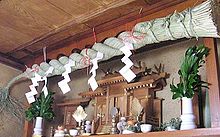Kamidana
Kamidana ( Japanese 神 棚 ) is the Japanese name for a Shinto house altar . Kamidana are small wooden miniature replicas of shrine buildings that are attached to the wall or placed in a raised niche. In Kamidana, the ancestors of the family or local deities ( Kami ) are worshiped.
A mirror is set up at the front of a kamidana, to the right and left are vases with branches of the bulky bush ( sakaki ) and votive candles , and a shimenawa (straw rope) is attached in front of the kamidana . The offerings to the kami, rice, salt, water, sake or fruit, are offered twice a month, on the first and 15th, in front of the shrine. The water is renewed every morning. As with the great Shinto shrine, the rite of worshiping the Kamidana is two bows, two claps and one bow ( 二 礼 二 拍 一 礼 , nirei nihaku ichirei ).
In the 1920s, the custom of setting up Kamidana in the dōjōs of budō associations spread in Japan . The term is often confused with "Kamiza" ( 上座 ), the place of honor in the room.
Buddhist house altars are also common in Japan, these are called butsudan . The tokonoma , a wall niche for decorations, is also of Buddhist origin. Sometimes there is a tamaya , usually below the kamidana .
Web links
- Okada Yoshiyuki: "Kamidana" . In: Encyclopedia of Shinto. Kokugaku-in , June 2, 2005 (English)
- Kamidana in the web manual Religion in Japan by Bernhard Scheid
- A manufacturer of Kamidana - Japanese
- A picture of kamidana - Japanese
